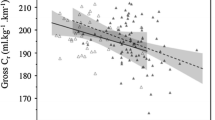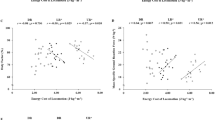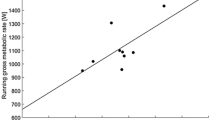Summary
The energy demand of running on a treadmill was studied in different groups of trained athletes of both sexes. We have not found any significant differences in the net energy cost (C) during running (expressed in J·kg−1·m−1) between similarly trained groups of men and women. For men and women respectively in adult middle distance runnersC=3.57±0.15 and 3.65±0.20, in adult long-distance runnersC=3.63±0.18 and 3.70±0.21, in adult canoeistsC=3.82±0.34 and 3.80±0.24, in young middle-distance runnersC=3.84±0.18 and 3.78±0.26 and in young long-distance runnersC=3.85±0.12 and 3.80±0.24. This similarity may be explained by the similar training states of both sexes, resulting from the intense training which did not differ in its relative intensity and frequency between the groups of men and women. A negative relationship was found between the energy cost of running and maximal oxygen uptake\((\dot V_{O_{2max} } )\) expressed relative to body weight (for menr=−0.471,p<0.001; for womenr=−0.589,p<0.001). In contrast, no significant relationship was found in either sex between the energy cost of running and\(\dot V_{O_{2max} } \). We conclude therefore that differences in sports performance between similarly trained men and women are related to differences in\(\dot V_{O_{2max} } \cdot kg^{ - 1} \). The evaluation ofC as an additional characteristic during laboratory tests may help us to ascertain, along with other parameters, not only the effectiveness of the training procedure, but also to evaluate the technique performed.
Similar content being viewed by others
References
Åstrand PO (1952) Experimental studies of physical working capacity in relation to sex and age. Munksgaard, Copenhagen
Åstrand PO, Rodahl K (1977) Textbook of work physiology. McGraw Hill, New York
Awan MZ, Goldspink G (1972) Energetics of the development and maintenance of isometric tension by mammalian fast and slow muscles. J Mechanochem Cell Motil 1:97–108
Bosco C, Komi PV, Sinkkonen K (1980) Mechanical power, net efficiency, and muscle structure in male and female middle distance runners. Scand J Sports Sci 2:47–51
Bosco C, Montanari G, Ribacchi P, Latteri F, Iachelli G, Faina M, Giovenali P, Colli R, Dal Monte A, La Rosa M, Cortili G, Saibene F (1987) Relationship between the efficiency of muscular work during jumping and the energetics of running. Eur J Appl Physiol 56:138–143
Bransford DR, Howley EG (1977) Oxygen cost of running in trained and untrained men and women. Med Sci Sports 9:41–44
Bunc V, Leso J (1980) A nomogram for converting the speed of running in dependence on the evaluation angle of the treadmill (in Czech.). Teor Praxe Těl Vých 28:422–425
Bunc V, Šprynarová Š, Pařízková J, Leso J (1984) Effects of adaptation on the mechanical efficiency and energy cost of physical work. Hum Nutr Clin Nutr 38C:317–319
Bunc V, Heller J, Pařízková J, Šprynarová Š, Leso J (1986) Changes of mechanical efficiency as a result of adaptation to an increased work load in different sports disciplines. In: Humphrey JH, Dotson CO (eds) Exercise Physiology II. AMS Press, New York, pp 133–143
Bunc V, Heller J, Leso J, Šprynarová Š, Zdanowicz R (1987a) Ventilatory threshold in various groups of highly trained athletes. Int J Sports Med 8:275–280
Bunc V, Heller J, Leso J, Bojanovský I (1987b) Nomograms for a conversion of running speed on a treadmill in the laboratory to that in the field (in Czech). Pracov Lék 39:170–174
Conley DL, Krahenbuehl GS (1980) Running economy and distance running performance of highly trained athletes. Med Sci Sports Exerc 12:357–360
Costill DL (1979) A scientific approach to distance running. Track Field News [Los Altos] 14:12–40
Cureton K, Bishop P, Hutchinson P, Newland H, Vickery S, Zwiren L (1986) Sex differences in maximal oxygen uptake. Eur J Appl Physiol 54:656–660
Davies CTM (1980) Effects of wind assistance and resistance on the forward motion of a runner. J Appl Physiol 48:702–709
di Prampero PE, Atchou G, Brückner JC, Moia C (1986) The energetics of endurance running. Eur J Appl Physiol 55:259–266
Drinkwater B (1973) Physiological responses of women to exercise. In: Wilmore J (ed) Exercise and sport sciences reviews, vol. 1. Academic Press, New York, pp 124–154
Falls HB, Humphrey LD (1976) Energy cost of running and walking in young woman. Med Sci Sports 8:9–13
Kaneko M, Fuchimoto T, Ito A, Toyooka J (1983) Mechanical efficiency of sprinters and distance runners during constant speed running. In: Matsui H, Kobayashi K (eds) Biomechanics VIII-B. Human Kinetics, Champaign, Ill, pp 754–761
Komi PV, Ito A, Sjödin B, Wallenstein R, Karlsson J (1981) Muscle metabolism, lactate breaking point, and biomechanical features of endurance running. Int J Sports Med 2:148–153
Margaria R (1938) Sulla fisiologia e specialmente il consumo energetico della mercia a della corsa a varia velocita ed inclinazione del terreno. Atti della R Academia Nazionale dei Lincei (Rendiconti) 7:299–369
Margaria R, Cerretelli P, Aghemo P, Sassi G (1963) Energy cost of running. J Appl Physiol 18:367–370
Menier DR, Pugh LGCE (1968) The relation of oxygen intake and velocity of walking and running in competition walkers. J Physiol (Lond) 197:717–721
Pugh LGCE (1970) Oxygen intake in track and treadmill running with observation on the effect of the air resistance. J Physiol (Lond) 207:823–835
Pugh LGCE (1971) The influence of the wind resistance in running and walking and the mechanical efficiency of work against horizontal forces. J Physiol (Lond) 213:255–276
Sparling P (1980) A meta-analysis of studies comparing maximal oxygen uptake in men and women. Res Q Exerc Sport 51:542–552
Sparling P, Cureton K (1983) Biological determinants of the sex difference in 12-min run performance. Med Sports Exerc 15:218–223
Von Dobeln W (1956) Human standard and maximal metabolic rate in relation to fat-free body mass. Acta Physiol Scand [Suppl] 126:1–78
Wendt IR, Gibbs OL (1974) Energy production of mammalian fast and slow twitch muscle during development. Am J Physiol 226:642–647
Zwiren L, Cureton K, Hutchinson P (1983) Comparison of circulatory responses to submaximal exercise in equally trained men and women. Int J Sports Med 4:255–259
Author information
Authors and Affiliations
Rights and permissions
About this article
Cite this article
Bunc, V., Heller, J. Energy cost of running in similarly trained men and women. Europ. J. Appl. Physiol. 59, 178–183 (1989). https://doi.org/10.1007/BF02386184
Accepted:
Issue Date:
DOI: https://doi.org/10.1007/BF02386184




